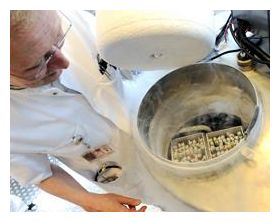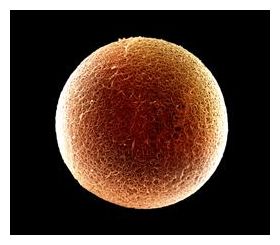
The first thing that Alison Hopkins did after finishing her PhD was freeze 14 of her eggs. She knew she wanted children, but she was 38 and didn't have a partner. "It buys you time, it eliminates any pressure," she says. "I thought it was a really good insurance policy."
For such women, however, egg freezing is "a shot in the dark", says Hopkins' fertility specialist, John Jain, who heads Santa Monica Fertility in California. Very few of the older women who have frozen eggs to beat the clock have tried to use them, says Jain. He estimates that, worldwide, fewer than ten babies have been born from eggs frozen for women aged 38 or over. And no one knows how successful the freezing and thawing of older eggs will be - despite the fact that most women now seeking the service are over 38.
These uncertainties are reflected in the recommendations of the American Society for Reproductive Medicine (ASRM) - the advisory body to the fertility industry - but not in the practices of its members, even some of those who formulate the guidelines. The ASRM states clearly that oocyte cryopreservation should not yet be offered to older women as a way of extending their fertility. It also says that all egg freezing should be considered experimental, and be performed as part of a research project governed by an institutional review board (IRB), which is supposed to monitor, review and approve the research.
ASRM practice-committee chair Samantha Pfeifer of Penn Health for Women in Radnor, Pennsylvania, says that there are still many unanswered questions. "How successful will this be for someone in her late thirties?" she asks. "That has not been evaluated in any randomized controlled trials." There is also debate about what technique works best. Some of the chemicals used in the freezing process are toxic to embryos, and no one knows how much the eggs absorb. Moreover, there has been no systematic follow-up of children born from frozen eggs.
Oocyte cryopreservation was originally explored to help women with cancer, because treatments such as chemotherapy can cause sterility. But, according to Briana Rudick, a fertility specialist at Columbia University in New York, the biggest demand is now from women electing to delay motherhood. Although Eric Widra, a member of the ASRM's practice committee, says that "almost nothing" is known about how well older eggs will freeze and thaw, the clinic he works for, Shady Grove Fertility in Washington DC, offers egg freezing to older women. It bills the procedure as a woman's chance to "lock in her fertility potential for future use", which is at odds with ASRM practice committee guidelines.
Although most fertility doctors go through the motions of doing research, such as getting IRB approval, many do not consider the procedure experimental, or their clients research subjects. "I completely reject their experimental designation," says Nicole Noyes at the New York University Langone Medical Center. She argues that egg freezing is now well established and has a high rate of success, and that in clinics with a proven track record it should not be singled out as needing special oversight.
Yet calling the procedure experimental without genuinely treating it as such leaves women with all the downsides of experimental science but few of the protections, says Gerald Schatz, vice-president of Citizens for Responsible Care and Research, a non-profit organization that works to improve standards for human research subjects. If it's really research, he says, there should be a carefully designed trial every time, results should be reported, fees should be reduced and there should be safety monitoring. The results should help to shape standard medical practice.
But the industry is a competitive one. And Pfeifer points out that many centres do not feel compelled to share their results. "That's unfortunate," she says, "because if everybody did, we'd know how it's going." This lack of transparency contrasts sharply with that for in vitro fertilization, for which the results of all cycles must be reported to the US Centers for Disease Control and Prevention in Atlanta, Georgia, either directly or through the Society for Assisted Reproductive Technology (SART), a sister organization to the ASRM. "We don't have the same transparency for egg freezing," says Widra, chair of the SART practice committee.
Short on science
Unlike new drugs or medical devices, which must be approved by the US Food and Drug Administration before they can be marketed, advances in medical techniques need no such mandate. Fertility treatments have been among the quickest to leap from lab to clinic. "There's a history of moving forward quickly in reproductive medicine," says Laura Shanner, a bioethicist at the University of Alberta in Edmonton, Canada. "There are endemic problems of poorly done, poorly structured research." Neither intra-cytoplasmic sperm injection (ICSI) - a technique that injects sperm directly into an egg - nor pre-implantation genetic diagnosis, for instance, went through lengthy testing in humans before being marketed.
The controversies surrounding egg freezing are not limited to the United States. In the United Kingdom, the Royal College of Obstetricians and Gynaecologists and the British Fertility Society issued a joint statement in 2009 warning that women should not look to egg freezing for non-medical reasons, but numerous clinics now offer the service. In the Netherlands, members of parliament voted in April to end a ban on non-medical egg freezing, allowing women up to age 45 to freeze their eggs.
"There may be some damage to cell organelles after thawing, which an older, unhealthier egg probably cannot recover from."Human eggs, which are large, aqueous and permeable, are tricky to freeze. One of two current methods, 'slow-freezing', involves dehydrating the egg using chemical cryoprotectants, then cooling it slowly to induce the formation of ice outside it. The egg is then cooled further to between about - 30 °C and - 40 °C before being plunged into liquid nitrogen. Unless great care is taken, ice crystals form inside the cell and destroy it. However, advances during the past few years have significantly increased success rates, and now as many as 50 - 90% of eggs can survive slow-freezing and thawing (J. Boldt Reprod. BioMed. 2011).
'Vitrification', a newer method, involves treating the egg with a higher concentration of cryoprotectants, then immediately plunging it into liquid nitrogen. When done properly, the solution within and surrounding the egg turns into a glass-like substance, which avoids the formation of damaging ice crystals. Between 80% and 95% of vitrified eggs survive.
Potential concerns with both techniques are that the cryoprotectants can be toxic to the egg, and that freezing and thawing might affect the egg's meiotic spindle, although spindles are generally thought to reform several hours after thawing.
Although some doctors expect that older eggs will survive freezing and thawing just as well as younger ones, many are not so sure. "Every embryologist will tell you that good quality eggs won't suffer from freezing, but older eggs may not do so well," says Claudio Benadiva at the University of Connecticut Health Center in Farmington. Rudick argues that, for this reason, older women should be included in studies. "There may be some damage to cell organelles after thawing, which a healthy egg can probably recover from, but an older, unhealthier egg probably cannot recover from," she says.
Worldwide, it is estimated that fewer than 2,000 people have been born from frozen eggs, about 400 of them in the United States. A substantial number have been born in Italy, where the freezing of embryos was not permitted until recently, but egg freezing was allowed. Only four babies had been born from frozen eggs by the end of March 2009 in the United Kingdom, according to the latest figures from the Human Fertilisation and Embryology Authority.
Importantly, almost all of the children were conceived from the eggs of young women, many of whom were egg donors. "You shouldn't assume a 42-year-old will have the same success as a younger woman," says Pfeifer. According to clinicaltrials.gov, only a few of the registered trials evaluating oocyte cryopreservation even allow healthy women over the age of 37 into the studies, and none of them is studying older women in particular. The ASRM says that it wants more data on egg freezing at all ages. "We would like to see larger studies," says Widra. "We'd like reproducibility."
Counting the cost
Despite the absence of data, fees for egg freezing can be high. The charge for hyperstimulating the ovaries, retrieving eggs and cryopreserving them can exceed US$10,000. Keeping them frozen will add another $500 or so a year, and thawing them costs around $1,000. Cryopreserved eggs must be inseminated using ICSI, which costs around $1,200 a session. All told, a single attempt at a child could cost close to $20,000. Even with fresh eggs, a single in vitro fertilization attempt gives women aged 38 - 40 only a 22% chance of a live birth. By age 43 or 44, that drops to just 5%. How much freezing and thawing will reduce those odds by no one can say.
Rudick recommends caution to women of all ages seeking to freeze their eggs. Her research shows that many clinics that offer egg freezing have limited experience in thawing the cells, let alone turning them into babies. In spring 2009, Rudick contacted every clinic in the United States, 64% of which responded. Of the 140 that provided data on their egg-freezing service and outcomes, 45 had never thawed a client's frozen eggs (B. Rudick et al. Fertil. Steril. 2010). At least 30 clinics had no live births from the eggs that they had thawed, and 11 more had achieved only one live birth. Only 8 respondents had managed 10 or more live births, she told Nature.
Nevertheless, for those women who calculate that a slim chance of having a child is better than none at all, the debate over how the procedure is designated and documented may be a minor concern in the face of an overriding hope. Before undergoing the procedure, Hopkins says, she researched it extensively. She was not surprised to hear that only a few children have been born from eggs the same age as hers, but is undaunted by the uncertainties surrounding the technology. "I don't see it as experimental," she says. "I'm very confident that I will end up with a live birth."




Reader Comments
to our Newsletter